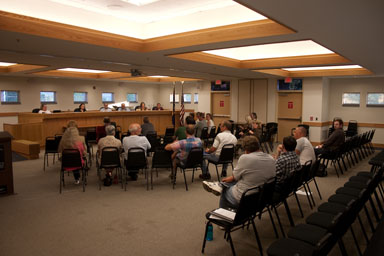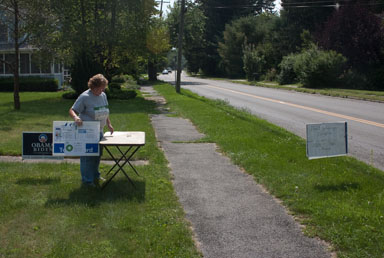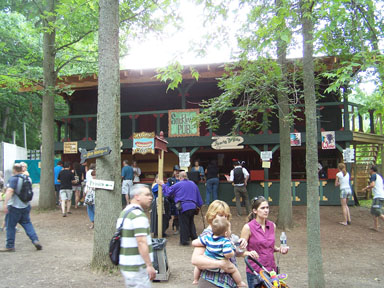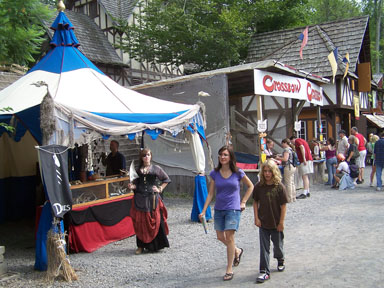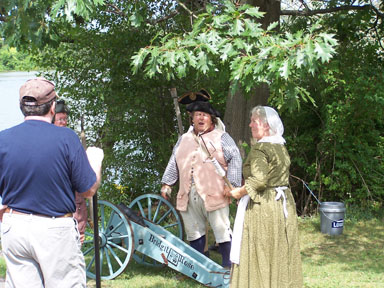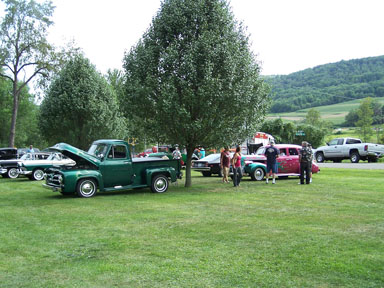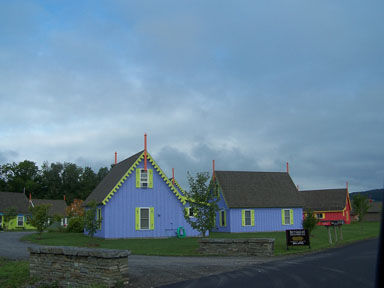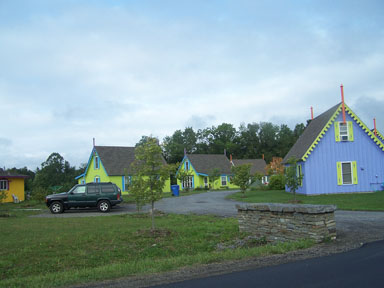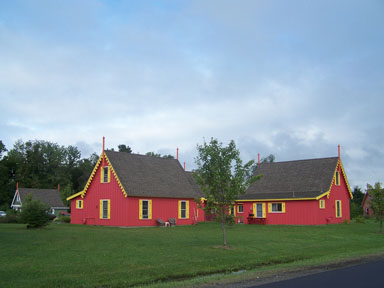August 2, 2010
Journal on draft Zoning moving to Town Board
Saturday's Ithaca Journal had a brief piece on last Thursday's Planning Board meeting where the Planning Board moved the new zoning draft to the Town Board, with recommendations for improvements and a process that includes multiple boards:
More work is needed on the second iteration of the town's controversial zoning proposal...
Planning board Chair Joe Lalley told residents at the meeting that all of their comments have been meaningful and are being taken into account, especially with regard to revisions of the proposed zoning map. He also added that he requested the town board solicit more public comment before the 4-year-old project was passed, which could happen as early as this winter.
The Journal spends a bit more time on the property owners who think the law is too restrictive than on the other half of comments from people in Varna who'd like to see more detailed planning in the hamlet. Those seem to be the two primary conversations as this moves along, though I suspect we'll hear more pieces emerge as this develops further.
(I did post the audio of the meeting in my earlier brief piece. I'll also have more thoughts on the draft - they're just taking a while percolating.)
August 4, 2010
Assault on James Street
Somehow "running his mouth" led to "severe head trauma" in a fight at a home on James Street.
Enfield opted to change from collecting their share of sales tax to applying it as a credit to their county tax to be able to collect some additional tax on state forest land. Dryden takes its share of sales tax directly. This is one of those corners of public finance where all of the choices are strange, and New York State's collection of rules can push towns in various directions. One side effect is that it makes it very difficult to compare town tax rates directly.
August 5, 2010
LaRouche supporters table in Freeville
When I first heard there were big "Impeach Obama" signs in Freeville, complete with the Hitler mustache on Obama, I was worried that the worst of Tea Party excesses had arrived in Dryden. When I got to Freeville, though, I calmed down pretty quickly. The protesters were Lyndon LaRouche supporters, who have busily protested all kinds of political and economic policies since before I was born, jumping from extreme left to extreme right in ways that are just hard to explain or even categorize.
The LaRouche folks seem to be working around the fringes of the Tea Party these days, offering literature with cheerful titles like "Act Now to Stop Obama's Nazi Health Plan!" and "Your Enemy George Soros", along with visions of an economy rebuilt by colonizing the moon and Mars. Bob Wesser was disappointed that I wouldn't take any, despite my recounting a few of LaRouche's previous greatest hits. (I already have more than enough in my attic from when I collected it in the 1990s.)

Bob Wesser shares a LaRouche literature collection.
They're apparently on a "Western New York tour", and I found this article on an earlier appearance in North Tonawanda.
Their arrival provoked Jean Simmons to get out her Obama/Biden sign and put up a new sign encouraging people to sign a petition for the August 10th "Fight Washington Corruption" rally in Cortland. She also had signs questioning the recent Citizens United decision freeing corporations to spend all the money they want on politics.
Hopefully the LaRouche tabling won't add too severely to the conspiracy theories already out there. I didn't have the heart to ask if they still thought the Queen of England is the head of a drug-dealing cartel.
August 6, 2010
Ellis Hollow westbound closed from Turkey Hill
This morning's Ithaca Journal reports on the closure of Ellis Hollow Road westbound from Turkey Hill Road to Thomas Road as construction begins.
In other road-related news, though just outside of Dryden, Forest Home is getting ready for some major road construction designed to slow the flow of traffic through their area. Forest Home is much like its neighbor Varna in that it has a cluster of older houses right on top of a busy road going to Cornell, though it's further complicated by almost all of that traffic having to cross one-lane bridges. Its being closer to Cornell certainly gives it some economic advantages, but it's not all that different a situtation.
For those who shop at the P&C stores in the Town of Ithaca, there's more grocery chaos coming as Tops agreed to sell those stores to settle a complaint about its dominance of stores in the area. I did wonder about having two stores across the road from each other on Triphammer.
If you're planning on going to next week's EPA natural gas hearing in Binghamton, there's a small problem: it's not clear where that hearing will be held.
August 7, 2010
Special districts
The Ithaca Journal loves to publish on municipal consolidation, and today's push looks at Cortland, Candor, and Ithaca. They also have a list of the number of special districts in Tompkins County, many of which are in Dryden:
| District Type | # in Tompkins | # in Dryden | Which |
|---|---|---|---|
| Lighting Districts | 20 | 3 | Varna, Etna, Meadow/Leisure |
| Municipal Districts | 17 | 3 | Town of Dryden, Villages of Dryden and Freeville |
| Water Districts | 17 | 6 | Varna, Snyder Hill, Monkey Run, Turkey Hill, Hall Road, Royal Road |
| School Districts | 15 | 5 | Dryden, Ithaca, Lansing, Groton, Cortland |
| Fire Protection Districts | 12 | 2 | Dryden (4 departments), McLean |
| Sewer Districts | 10 | 7 | Varna, Cortland Road, Monkey Run, Turkey Hill, Peregrine Hollow, Royal Road, Sapsucker Woods Road |
| Drainage Districts | 3 | Don't know of any | |
| Ambulance Districts | 1 | Dryden Ambulance is townwide | |
| Business Development Districts | 1 | Dryden does have an Industrial Development Agency | |
| Solid Waste Districts | 1 | Think this is the whole county. |
This also reminds me that the Town stuck a lamppost at the intersection of 79 and Brooktondale Roads without forming a district a few years ago. I believe the lighting along the 13/366 overlap belongs to the state, as well.
There's also a blog piece on the history of school district consolidation that leaves me thinking we'd be wise to be cautious about running ahead into consolidations generally.
The health violations list is out.
Crossing from the county level to the state, Tompkins County Legislature Chair Martha Robertson was named to serve on the New York State Association of Counties' Presidential Commission on the State Takeover of Medicaid.
August 9, 2010
Orchid Place profiled
This morning's Ithaca Journal visits one of my neighbors, The Orchid Place, telling the story of Tony Liu's business and how it's growing. I had no idea they were getting tour buses, but it's a great idea - there's lots to see there. They also list his tips for orchid care.
In other gardening news, keep an eye out for late blight if you have tomatoes or potatoes.
Holly Fodge of Freeville writes a letter about Ithaca's Amy Crockford case.
Sterling Renaissance Festival
Yesterday, Angelika and I took Sungiva and Konrad to the Sterling Renaissance Festival with our friends Rolf and Susan Verberg, and their son Simon. They'd been there a few times, but it was a first for us.
Yes, of course there was jousting:
There were also pirates:
A lot of the fun, though, was just the place and the people. It's an established festival with lots of buildings and little businesses, offering crafts, food, and entertainment. The jousting is a big draw, but there so many smaller shows we didn't get to see.
It certainly wasn't jousting, but Angelika and Sungiva enjoyed their ride on a warhorse!
I've also posted a gallery of the festival, with lots more to see. I think we only walked about two-thirds of it in about six hours. It's definitely worth going there all day, and I'm sure we'll be back!
It's been a while since I posted an excursion story.
Ithaca metro area earnings growth in private sector
I know Tompkins County has a more stable economy than the rest of Upstate New York and even lots of other places, but I didn't expect to see this in a report today on income shifts in Metropolitan Statistical Areas (MSAs):
In most of the 57 MSAs where net earnings increased, the gains were concentrated in the government sector. Military earnings growth was particularly strong in seven of the ten MSAs with the fastest personal income growth in 2009: Jacksonville and Fayetteville, North Carolina; Manhattan, Kansas; Elizabethtown, Kentucky; Lawton, Oklahoma; Clarksville, Tennessee; and Killeen, Texas.
Only in five MSAs (Kennewick, Washington; Cumberland, Maryland; Morgantown, West Virginia; Cape Girardeau, Missouri; and Ithaca, New York;) did the private sector account for most of earnings growth in 2009.
We didn't do all that well per capita, though, as the table below - for New York State and nearby MSAs shows:
| Total personal income, millions of $ | Per capita personal income, $ | ||||||||||
|---|---|---|---|---|---|---|---|---|---|---|---|
| Area | 2007 | 2008 | 2009 | 2008 | 2009 | 2007 | 2008 | 2009 | Rank, 2009 | % change 2008 | %change 2009 |
| Albany-Schenectady-Troy, NY | 34,883 | 36,327 | 36,291 | 4.1 | -0.1 | 40,941 | 42,523 | 42,318 | 46 | 3.9 | -0.5 |
| Binghamton, NY | 8,066 | 8,415 | 8,348 | 4.3 | -0.8 | 32,870 | 34,367 | 34,116 | 198 | 4.6 | -0.7 |
| Buffalo-Niagara Falls, NY | 40,778 | 42,317 | 42,155 | 3.8 | -0.4 | 36,216 | 37,647 | 37,511 | 115 | 4.0 | -0.4 |
| Burlington-South Burlington, VT | 8,258 | 8,517 | 8,582 | 3.1 | 0.8 | 40,059 | 41,139 | 41,247 | 56 | 2.7 | 0.3 |
| Elmira, NY | 2,788 | 2,942 | 2,899 | 5.5 | -1.5 | 31,656 | 33,469 | 32,814 | 241 | 5.7 | -2.0 |
| Ithaca, NY | 3,251 | 3,420 | 3,423 | 5.2 | 0.1 | 32,374 | 33,856 | 33,632 | 212 | 4.6 | -0.7 |
| Glens Falls, NY | 4,087 | 4,248 | 4,249 | 3.9 | 0.0 | 31,833 | 33,018 | 32,994 | 233 | 3.7 | -0.1 |
| Kingston, NY | 6,488 | 6,694 | 6,619 | 3.2 | -1.1 | 35,738 | 36,836 | 36,481 | 135 | 3.1 | -1.0 |
| New York-Northern New Jersey-Long Island, NY-NJ-PA | 1,018,093 | 1,041,636 | 998,777 | 2.3 | -4.1 | 53,864 | 54,914 | 52,375 | 9 | 1.9 | -4.6 |
| Pittsfield, MA | 5,462 | 5,602 | 5,590 | 2.6 | -0.2 | 41,941 | 43,237 | 43,240 | 38 | 3.1 | 0.0 |
| Poughkeepsie-Newburgh-Middletown, NY | 26,126 | 26,961 | 26,598 | 3.2 | -1.3 | 39,109 | 40,119 | 39,282 | 76 | 2.6 | -2.1 |
| Rochester, NY | 39,852 | 41,132 | 40,586 | 3.2 | -1.3 | 38,635 | 39,812 | 39,192 | 78 | 3.0 | -1.6 |
| Scranton-Wilkes-Barre, PA | 18,807 | 19,445 | 19,747 | 3.4 | 1.6 | 34,244 | 35,399 | 35,940 | 148 | 3.4 | 1.5 |
| Syracuse, NY | 23,069 | 23,852 | 23,766 | 3.4 | -0.4 | 35,797 | 36,980 | 36,784 | 130 | 3.3 | -0.5 |
| Utica-Rome, NY | 9,275 | 9,656 | 9,698 | 4.1 | 0.4 | 31,614 | 32,975 | 33,069 | 231 | 4.3 | 0.3 |
| Williamsport, PA | 3,529 | 3,657 | 3,733 | 3.6 | 2.1 | 30,208 | 31,344 | 31,950 | 265 | 3.8 | 1.9 |
There are 366 total MSAs, which helps make some sense of the 'rank'.
Thursday EPA hydrofracking forum moves to Syracuse
Scheduling this has been a trainwreck - apparently they've now left Binghamton altogether and moved to Syracuse. It starts at 8:00am, and runs all day through 10:00pm, with noon and 5:00pm breaks for meals.
August 10, 2010
Weekend backpack program grows
Dryden Daily KAZ reports from the Dryden Board of Education meeting that Dryden schools, with support from Sertoma, local churches, and the Girl Scouts have sent food home with 24 elementary school children, and will be growing up to 36 this year.
Commercial real estate hangovers
As I drive around Tompkins County, whether in downtown Ithaca, Triphammer Road, or along Route 13 in Dryden, I keep seeing "for rent" signs on commercial buildings. Some of that has to do with the economic downturn, some has to do with seasonality.
A lot of these buildings have been empty or marginal for years, maybe even decades. I'm pretty sure the empty Yellow Barn Commercial Park with its new big signs has been there for decades. I remember looking at the Prudential building on 13/366 back in 2001. Even Pyramid Mall - sorry, The Shops at Ithaca Mall - has felt weak for a long long time.
Does hope really spring eternal? Tompkins County certainly has more large retail than it used to, but lots of this space gets used only occasionally, if at all. People keep building more and more new places, but they don't all seem to find tenants. Even some that do find tenants - like the development on 13 that held Office Depot and Office Max and AAA and Hollywood Video - just can't hold tenants, and evolve to empty.
The Dryden Community Center Cafe has made the four corners area in Dryden a much more frequent destination for me, but the area still hasn't recovered from the departures of a few years ago.
As Dryden ponders zoning, let's try to remember that we - and the surrounding area - aren't actually using all we have particularly efficiently.
August 11, 2010
EPA hydrofracking forum postponed
I'm surprised this has been so incredibly difficult (it wasn't at previous meetings), but Thursday's EPA public meeting on hydrofracking is cancelled, the event postponed until likely September.
Ellis Hollow Road dangers
Apparently closing one lane of traffic for construction isn't working out so well - motorists seem to go the wrong direction enough to be a problem. Be careful!
Dryden Lake Festival Saturday
It's just about here - the Dryden Lake Festival will be this Saturday, August 14th. They'll be having races - including canoe races and a 1K paddle/5K run race - in the morning, with music and classic cars in the afternoon and fireworks at night. Water dog demonstrations and a Revolutionary War demonstration will add to the variety.
Cathy Wakeman's Dryden Town Talk looks over the festival, as well as work to make the Dryden Community Center Cafe more accessible and Saturday's barbecue at the Varna United Methodist Church.
August 16, 2010
Dryden Lake Festival
I only managed to get over to the Dryden Lake Festival for a few hours on Saturday, but it was amazing. I loved the Revolutionary War reenactment tent, and not just because they were firing cannons and muskets.
I saw a few canoe races, and went out twice myself. Unfortunately the Dryden Republicans beat the Dryden Democrats every time - it happens. The lake was beautiful, and they had a fishing derby and water dog demonstrations going on. There were also vendor booths selling various foods, items, and ideas.

Presenting Ithaca Organics, grown in Dryden.
The classic cars were a fine component. I seem to have taken up gardening and stonework this summer, so probably can't take up auto repair too, but it's always nice to see cars built in an age when the insides of cars were supposed to be interesting to their drivers.
We missed the fireworks, as an extended stay in the bouncing tent made Sungiva just a little tired. She loved the horse, goats, and alpaces too. The music we heard was great, and it was good to see so many people out on a beautiful day in a beautiful place.
I've also posted a gallery with lots more to see.
August 19, 2010
Town Board takes on zoning
The Town Board took a more direct role in drafting the final zoning ordinance than the Planning Board suggested at the end of August.
Instead of convening a new task force including members of the Town Board, Planning Board, Zoning Board of Appeals, and Conservation Board, the Town Board decided to focus on this project themselves, during their first meeting of the month. (This year, they've had a first monthly work meeting, though open to the public, and then the regular public meeting, which is generally things the public will find more interesting.)
Steve Stelick suggested the idea, but board members seemed to jump on it. There were questions about the use of email, which Supervisor Mary Ann Sumner clarified would be only for agenda-setting and question collecting. The public will have a chance to speak at the end of these working meetings, but there wasn't a broad discussion of when in the process they'll solicit public input.

August Dryden Town Board meeting.
Most of the audience and the speakers were from the Varna area, and the board separated the Varna work from the rest of the zoning. Work toward a Varna Master Plan went back to the Planning Board and the consultant who's been working on the zoning so far. I probably should have asked what that separation would mean for Varna's status in the zoning draft the Town Board will be working on.
The first of these meetings will be September 8th, with the regular non-zoning business starting at 7:00pm and the zoning conversation starting when that's done, likely around 8:00pm. It sounded like they'd be taking up setbacks, one of the parts of the law I've heard no complaints about.
I don't have a clear picture of how this affects the likely outcome of the zoning process. I like that the Town Board members are now going to be clearly responsible for the work, but beyond that I'm not certain how quickly this will flow or what kinds of public input they'll be seeking. I doubt they'll rush it through, at least, but there's still a lot to watch here.
August 20, 2010
Lots of small Ithaca Journal pieces
The Ithaca Journal's news coverage keeps shrinking, and the paper is looking more and more like a general Upstate paper with stories of local interest. There are still lots of interesting bits, but overall I find it less compelling every month.
That lack of coverage got them plenty of flak for their minimal coverage of the benefit for Ithaca police officer and Etna resident Bryan Bangs, who lost his house to arson last month.
Dryden schools extended Superintendent Sandra Sherwood's contract through 2015.
Stephanie Lyon, a recent Dryden High graduate, writes about life in Tanzania.
Sustainable Tompkins gave the Dryden Community Garden a $630 grant for deer fencing.
Former County Adminstrator Steve Whicher, a Dryden resident, has a letter supporting Sheriff's challenger Ken Lansing.
Peter Harriott, also of Dryden, writes about energy generation math.
There's a new Tompkins County bicycling map available. You can find the map here. I worry that if Dryden Road (Route 366) in front of my house is "very good", that anything less than that must be terrible. I did ride to the Varna Fire Company and back last night without incident, though there are lots of spots in the shoulder inviting accidents.
The Dryden Recreation Department will be offering a magic class the afternoon of August 24th at the Dryden Community Center Cafe.
The strange saga of garbage truck regulation may finally be sorting out, after a series of twists and turns that mostly make me depressed about state government.
Finally, I suspect that deer in Dryden may be wondering the same things as the deer in Danby.
August 25, 2010
Reflections on the Republican Governor primary
A Dryden resident suggested I post a link to this discussion of the Republican primary for Governor. Republicans seem to have a lot more primaries this year at the state level than Democrats, and I have to admit I've not been paying close attention.
August 27, 2010
Varna Fire Company bunkhouse ready for use
The Varna Volunteer Fire Company has built a new bunkhouse, a building neatly hidden behind their station that lets them provide housing to up to eight fire personnel who will be ready to respond to calls quickly.
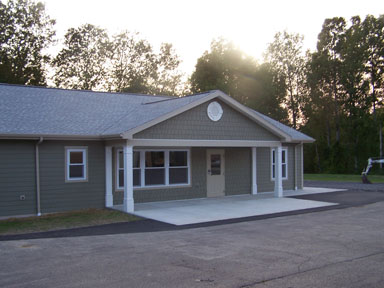
VVFC bunkhouse ready for work.
The VVFC has been talking about a bunker program for longer than I've been running this site. Cayuga Heights and Dryden both have bunker programs, which make it far easier to ensure that responders are ready to leap out the door whenever there's an emergency.
The rooms are small and spartan, but nice:
I've posted a gallery of photos showing the construction of the bunkhouse over time and its current pristine interior. I'm sure it will be getting a lot of use in years to come.
(I joined the Varna Volunteer Fire Company as a supporting member back in January. No, I'm not leaping into burning buildings - I'm writing software that prints badges for the people who do that, and who do a whole lot more. I figured I'd be done by February or early March. At the meeting I attended, they were wrapping up the plans and financing for their new bunker program, but hadn't yet broken ground. They finished building the bunkhouse at just about the time I finished my badge project for them.)
Wind farms and radar
I'd heard that the primary reason that Cornell abandoned its 2005 plans for a wind farm on Mount Pleasant was the Federal Aviation Administration. This had come up in Dryden meetings, and there was a poster at the East Hill Flying Club, but I didn't know how seriously to take it.
Apparently, this is a common issue near airports both civilian and military, and not just because of the towers' danger to flight paths:
Moving turbine blades can be indistinguishable from airplanes on many radar systems, and they can even cause blackout zones in which planes disappear from radar entirely. Clusters of wind turbines, which can reach as high as 400 feet, look very similar to storm activity on weather radar, making it harder for air traffic controllers to give accurate weather information to pilots...
Eliminating turbine clutter on radar is complicated. Part of the challenge is that many radar systems in use in the United States date back to the 1950s and have outdated processing capabilities - in some cases, less than those of a modern laptop computer. While there are technology fixes to ease interference on these aging systems, it can be tricky to filter out just the turbines.
On radar, "a wind turbine can look like a 747 on final approach," said Peter Drake, technical director at Raytheon, a major provider of radar systems. "We don't want to have the software eliminate a real 747."
The Energy Department is optimistic that all of these issues can be sorted out, but I'm guessing that in the short term this means that large scale wind farms in the immediate vicinity of Tompkins County Airport, especially near the flightpaths, is not likely to be a popular idea with a particular special interest that can actually stop things.
August 28, 2010
VVFC honors former Chief Ted Szymanski
I've noticed for a few years that the flags on fire stations and at the State Police are sometimes at half staff when the rest of the flags in the area are flying normally. This week, I got to know about one of those half-staff flags, and had the honor of seeing it lowered to be given to the family.
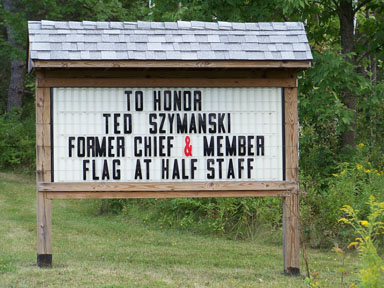
VVFC explains half-staff flag.
Ted Szymanski was chief of the Varna Volunteer Fire Company in the early 1980s after years as a volunteer, captain, and deputy chief. He was a fire instructor as well, an adjunct instructor at the NYS Academy of Fire Science in Montour Falls and the National Fire Academy. By day, he was a math professor at TC3.

Ted Szymanski as Chief of the Varna Volunteer Fire Company.
Szymanski's wife Mary told some of Ted's stories. My favorite was the one where he was inside a burning building and a phone kept ringing. He finally picked it up, and explained that he was fighting a fire. The woman at the other end thought it was a strange joke the owner of the house was pulling to get out of finishing some work for her. He got back to fighting the fire, but half an hour later a car pulled up, the woman got out, and marveled that yes, there really was a fire there.
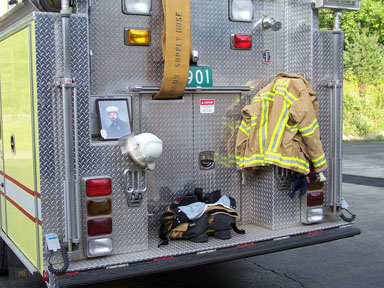
Turnout gear arranged in memory.
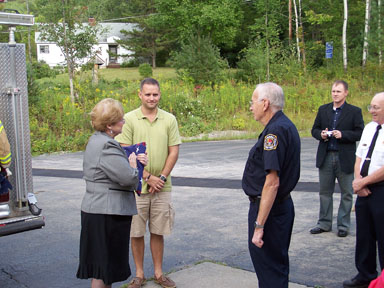
Mary and Sean Szymanski accept the flag from Duane Testut and Chief Roy Rizzo.
I've posted a much larger gallery of the family's visit and receiving the flag.
Why would you want to ban the corner grocery?
The closer I look at Dryden zoning - both the existing zoning and the proposed zoning - the more I wonder about the value of zoning. I recognize that it's a compromise, meant to keep people with no interest in their neighbors from wrecking the place, but sometimes...
I've gone to Brookton's Market a few times lately in the morning with Sungiva. It's kind of out of my way (7 miles), but I needed to take pictures in the area, and any time I'm in Brooktondale and they're open, I stop.
It's not your average convenience store - for one thing it has produce. It has a comfortable place to sit in the front, complete with child-size chairs that Sungiva loves and children's books she explores. They combine a small grocery store with a deli, desserts, and coffee shop, creating something very comfortable that I'd love to see in my neighborhood.

Seating at Brookton's Market, Brooktondale.
The main complaint I've heard about the place is that it's expensive. I suspect that's true compared to Wegmans or Aldi, but if I compare it with its typical gas station peers you get either more or better for your money. (Yes, I drink gas station coffee nearly every day.) It's strange how a space that invites you to stay awhile can have an effect, especially if that space isn't all formica or plastic, and the impact of seeing produce in a universe typically filled with processed food is huge.

Looking into Brookton's Market.
So great, this is a very nice model, and you certainly could build it where Dryden's convenience stores are now. We're not banning anything in Caroline with Dryden zoning, right? So what's the problem?
A place like this would be great in Ellis Hollow, maybe near the Ellis Hollow/Ellis Hollow Creek intersection, which has lots of subdivisions to its east. That intersection is 4 miles to the convenience store in Slaterville Springs, 4.3 miles to P&C in East Hill Plaza, 5.4 miles driving to Brookton's Market, and 5.5 miles to Ludgate Farms over on Hanshaw. The neighborhood certainly could support the slightly higher price of the food, and avoiding five mile trips is generally a good thing. When gas prices are high, a local source of food would be an even better thing.
Nope. Not allowed, period. From about Stevenson Road south and almost to Hollister Road east (except on German Cross), the southwest corner of Dryden is currently zoned R-B, the most restrictive zoning in the Town. It's slated to be zoned RR, Rural Residential, the most restrictive zoning available, or CV, conservation, which still doesn't allow retail. The list of allowed uses for R-B is short enough that I don't mind typing it:
Section 701. Allowed Uses.
One family, two-family dwellings
Farming, farm buildings, gardening, nurseries, greenhouses and the raising of livestock and poultry.
Existing farms; roadside stands for the sale and display of farm products provided that any such stand shall be at least 50 feet from the road center line. (See Section 1502.3).
Educational buildings, churches, community buildings, and other semi-public structures.
Private garages.
Home occupation of a professional or service nature when such activity is located entirely upon a residential lot and operated by the person living in said residence (see Section 1502.5)
That's all that's allowed - except that by special permit you may be able to have "not more than two employees" for a home occupation. "Professional or service nature" means that you're not selling objects. The new zoning is barring "Retail Business - Any establishment selling goods to the general public for personal and household consumption."
I understand that Ellis Hollow might not be seeking convenience stores, and that it's difficult to write zoning that allows certain kinds of stores while prohibiting others. Still, it seems odd at best that Ellis Hollow residents are forbidden short trips to buy food.
(Yes, it is possible to request a change in law when a specific project becomes a possibility, but it is much more involved than requesting a variance or even a special use permit.)
The only real bright side I can see is that maybe this would encourage someone to build such a thing in Varna, where it's likely to be allowed however the zoning turns out. That would be good for me, but not really the right answer.
What became of the Ellis Hollow Church?
While looking for something else, I stumbled on this set of videos showing the remodeled Ellis Hollow Church and its carriage house. They're advertising vacation rentals - 3000 square feet for the church, 1500 square feet for the carriage house. (Perfect Painters - Heritage Builders own the place and did the work.)
The church closed in 2004 and was remodeled in 2007.
More quick hits from the Ithaca Journal
It was a pretty quiet week for Dryden in the Journal. Harvestation, though, may be one of the best applications of technology to come out of Dryden in a while:
Harvestation.com, a local online bulk buying marketplace which went live in June...
The site is an outgrowth of the need for a connection point where local homesteaders, canners and big families can buy local and organic produce in bulk, said Katie Quinn-Jacobs, a local preserving expert and founder of the site, along with her husband David and friend Allison Fromme.
The Finger Lakes Land Trust will be celebrating a 39-acre addition to their 120 acre Ellis Hollow Nature Preserve, Pearman Woods, on September 16th at the Ellis Hollow Community Center. (The Town's posted a hiking map of the older preserve. There is a parking lot there now.)
Dryden Town Talk focused on an amazing sunflower, and noted a Lions Athletic Club meeting and Dryden Youth Opportunity Fair coming up.
Dryden also got a shout-out in a piece about Cornell's Cascadilla Hall:
In 1862, Dr. Samantha Nivison, the founder of a water cure in Dryden, approached Ezra Cornell and other prominent Ithacans about establishing a similar institution in Ithaca and combining it with a medical program for female students. With their logistical and financial support, she believed such an institution could thrive. Water cures, or hydrotherapy, were popular in mid-19th century America. They involved people bathing and soaking in water for extended periods, often with wet cloths on their heads, and drinking large quantities of pure or mineral water. Most of the water cures in the United States were in the Northeast, especially upstate New York, including Elmira, Oswego and Dansville.
Unfortunately, despite Cornell's support, Cascadilla Place (as it was then called) struggled. By 1868, after years of difficulties, including construction delays and insufficient funding, the Cascadilla Place Corporation came under the control of the newly opened Cornell University. Renamed Cascadilla Hall, it eventually became a dormitory for students and new professors.
Finally, the Journal mentions the Town of Dryden and the Villages of Freeville and Dryden in a piece about municipal employee pay. Unfortunately, all they do is average employee pay and rank those averages. In a really broad sense, those averages tell you something sort of, but they also fail to reflect what kind of distribution of jobs given municipalities have (lots of highway staff, or a few making overtime?) and what kinds of work they have to do. I'm not especially surprised, given the size and complexity of the towns, that Caroline's average is $26,972 while Dryden's is $34,150 and the Town of Ithaca is $47,674 - but what makes that happen? And why is the Town of Groton's average higher at $35,911 than the Town of Dryden's?
Maybe publishing the averages will get people to ask questions, but this list provides very few answers.
August 30, 2010
Another zoning boundary case
Near the end of the July meeting on the proposed zoning, builder Bruno Schickel asked why the tables in Sections 605 and 606 set a limit of four units per acre on individual single-family homes. Other approaches in those tables, which I thought allowed far too much density period, allowed up to ten units per acre.
While I understood (though disagreed with) most of Schickel's other points, that one left me wondering. The Fall Creek neighborhood in Ithaca is about 5 or 6 units per acre, and I'm pretty sure that Corning, where I grew up, stays below 8 units per acre when single family homes are the model. I understand that smaller (and taller) houses can work very well on smaller lots, but what might tempt us to experiment with such a thing? Dense housing developments in Dryden are generally - well, they're generally not especially attractive.
While looking around , though, I found a link to one of his more striking projects, Boicevillle Cottages in Caroline. It's a dense little neighborhood of distinctive houses surrounded by largely empty fields. As both Tompkins Weekly (page 2) and today's Ithaca Journal report, he's planning to build another 37 of those on 11 acres.
That's only 3.3 units per acre, though judging by the comments on the Ithaca Journal article, it's too much for some people:
The tree huggers love that type of layout; clustered houses around a commons area, or in modern green terminology, "open space". Its the same stuff the Eco-Villagers do, and its a throwback to the Puritan days when you were expected to live around the commons area so your neighbors could keep an eye on your daily activities to ensure you weren't falling into godlessness. - BFranklinsGhost
Maybe those are the reasons Dryden zoning prohibits more than 4 single-family homes per acre?
No, not really, especially as these are rental units anyway. It's worth considering a hypothetical, though. Saunders Greenhouse is for sale, just three doors up the road from me. The listing, citing current zoning, says that:
Zoning call for up to 135 units, but will be affected by grade issue.
Those are some serious grade issues, and the proposed zoning would limit it to more like 90 units, but could I imagine a development of these kinds of 800-1500-square-foot cottages there? Without wincing?
Yes, I can - though maybe the paint colors on the houses visible to the road and the neighbors could be, maybe, just a little more muted?
The problem, though, is that most developers aren't Bruno Schickel. It's not just that they paint houses in duller colors or wrap them in vinyl siding, but that they set out to create ordinary dullness in ways that will net them maximum profit. Schickel's creations, at least the ones I've seen and heard about, seem to get a lot more thinking before they start building. It's not just architectural madness, funky trimmings and such, either - Boiceville Cottages definitely sets out to create a community, even if it's a community in an isolated location. (It doesn't attempt to be Ecovillage, either.)
To run the Saunders Greenhouse hypothetical another way, I don't have high hopes that most developers of large-scale apartment complexes would put anything on that land I'd regard as something other than blight. I get a headache just imagining a Varna II style layout there, maximum boxes made possible by massive retaining walls.
I suspect there are other people in Dryden who think I'm crazy for liking Schickel's cottages, and who'd like to make sure that even that can't happen. From my perspective, though, I could agree with Schickel's questioning the rules - if most developers created work like his.
Since they don't, however, I think even the rules Schickel finds too constraining to be too loose.
Traffic count map
How many cars go by every day? Well, New York State seems to think about 7,383 pass my house each day. It could be worse - the 13/366 overlap has 18126, and Route 13 between there and the Village of Dryden shows 14,253.
The Department of Transportation has put together a searchable map of traffic counts. This shows the greater Dryden area:
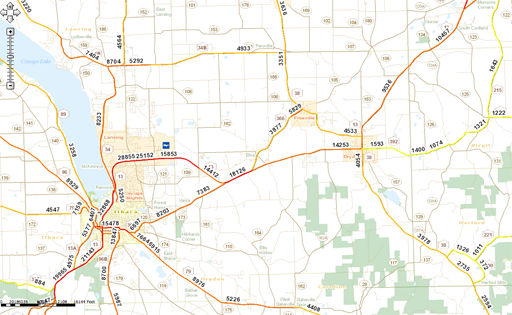
State highway traffic counts (Click to enlarge).
It would be an even better map if it included counts for smaller roads, no doubt.
(Thanks to Andy Arthur for pointing this out.)
The curse of water and sewer
When I was buying my house, there was a small problem. The mortgage folks wanted a water test, and we hadn't done one. Why hadn't we done one? Because although the house has a well, it only goes to the garden faucets these days. It's on Bolton Point water, and connected to the sewer system as well. That got us through that hoop, though it also took a few years before I could convince my insurance company that there was a fire hydrant just down the way. Apparently water and sewer are largely invisible, even to the people who track infrastructure. I didn't think hard about it at the time, though maybe I should have.
You can, however, see it by searching for fire hydrants, pumping stations, and manholes, or by tracking down maps like the one in the 2005 Comprehensive Plan:

Infrastructure in Dryden (Click to enlarge and see the whole town).
There are only two large areas with both water and sewer in the Town. The first follows 366 from the Ithaca line out to some of the Route 13 area, and then goes east from there along 13, Lower Creek, and Hanshaw Roads. The other is the Village of Dryden and some of its customers. Some areas along Freese Road have water but not sewer, and there's a tiny area south of Snyder Hill Road which has both water and sewer.
When I first moved in, I was delighted to have tap water that tasted better than the sulfury garden water, and not to have to worry about a septic tank and leach field. Yes, the taxes are significant - no question! - but maintaining wells and septic systems isn't a free lunch either.
I was surprised by the rush to reject a water district in Ellis Hollow in 2006, though probably less surprised by the rejection than that it had come up at all. Development follows infrastructure, after all, and Ellis Hollow is also even more spread out than the expensive Turkey Hill water and sewer district area. It just wasn't going to happen.
The Comprehensive Plan and the Draft Zoning both push hard on concentrating development in areas that already have infrastructure. From a planning perspective this makes sense, as septic systems are hazardous in densely populated areas, infrastructure is expensive, concentration allows the creation of neighborhoods, and in some ways can reduce transportation costs.
From a resident's perspective, though, this is not much fun. Most residents have no plans to build even four units, much less ten units, on their property, yet pay lots of taxes for the privilege of letting someone build developments they might not even support. Many of these taxpayers have lots or frontage too small to let them take advantage of such possibilities, even if they see them as an opportunity.
The result is that living in an area with water and sewer districts - but no local village - is a risky proposition. Developers are steered to your neighborhood by default, and because that neighborhood contains only around a tenth of the residents in the town, you lack political clout to say no.
The two most common reasons I've heard for why people live in Dryden instead in denser areas are that they want to live in the country and it's cheaper. The infrastructure doesn't help on either count. (Community is another part, though generally folks have to live here a while to see that, and I don't think I can make a plausible case that this infrastructure helps much on that count.)
The existing western area covered by the water and sewer districts is pretty much stuck, unless it can find the wherewithal to form a village and take control of its own destiny, as the Village of Dryden certainly has. In the meantime, we'll be forced to keep a paranoid eye on the Town of Dryden - and I'm happy to report that lots of Varna residents have indeed been showing up to meetings.
The zoning also contains Optional Neighborhood District Overlay areas around Etna and south and east of the Village of Dryden. Perhaps recognizing that cranking up the allowed density to the levels permitted by the hamlet and commercial zoning (10 dwellings/acre) would ensure that those areas avoid ever getting water and sewer infrastructure, the maximum density there is set to six dwellings per acre.
My strong advice to those areas, though, would be to avoid water and sewer unless there's a catastrophic need or you can form or join a village and localize land use decisions. The current planning model may make sense on a macro scale, but it has the really nasty side effect of inducing paranoia about your neighbors once you've read what's allowed in areas with infrastructure, and "in-between densities" are worth worrying about.
Perhaps New York State's efforts to reduce the overall number of municipal governments might better be served by trying to consolidate the piles of water, sewer, and lighting districts into villages than by encouraging villages to dissolve.
August 31, 2010
County Budget Discussion Thursday night at Dryden Cafe
Tompkins County Legislators will be hosting a meeting Thursday night to discuss the upcoming 2011 budget at the Dryden Community Center Cafe:
Dryden Community Meeting on the 2011 County Budget - Thursday, September 2
The latest in a series of community meetings to discuss next year's County budget is coming up Thursday evening, September 2 in Dryden.
The meeting will be held at the Dryden Community Cafe, 1 West Main Street in the Village of Dryden, beginning at 7:00 p.m.
The session is sponsored by County Legislators Michael Lane (District 14), Martha Robertson (District 13), and Brian Robison (District 9). The session is free and open to the public, and everyone is encouraged to attend.
The session will provide citizens the opportunity to learn about the fiscal challenges the County faces as it prepares for 2011 and to advise regarding how the County should respond.
"We are in economic crisis," Legislator Lane states. "The effect of limited revenues and unfunded state mandates places Tompkins County between the rock and hard place of cutting programs or raising property taxes. We are bringing this budget presentation to the Town of Dryden to inform residents about the process and to seek their thoughtful comments. I want to hear from people in the Dryden and Freeville area about what actions I should take as their County Legislator."
"We have some really tough choices to make; there can be no 'sacred cows' this year," Legislator Robertson cautions. "Everything is on the table, so it's very important that taxpayers understand what the choices are and give us their feedback. I'm pleased that we can offer this session in Dryden, and I hope neighbors can find the time to join us on September 2."
This is the fourth in the series of legislator-sponsored community meetings on the budget. Similar sessions have already been held in the Towns of Lansing and Ithaca, and in the City of Ithaca's Fall Creek neighborhood.
For more information on the upcoming community meeting, contact Legislator Lane at 844-8313; Legislator Robertson at 274-5434 or 272-0584; Legislator Robison at 351-3601; or Tompkins County Public Information at 274-5555.
If that sounds familiar, it echoes this Ithaca Journal story. No, I didn't copy the Journal. The quote above is the press release the county issued, and the Journal's "staff report" is the press release edited slightly to fit their style.
It should be a good meeting, though, and an opportunity to see just what goes into these difficult conversations.
New high school principal, hydrofracking forum rescheduled
Today's Journal has a report on Karen Rachetta, Dryden High School's new principal.
The EPA forum on hydrofracking that was cancelled in August is now rescheduled for September 13th and 15th in Binghamton. There are more speaker slots available to those who call in Friday.
